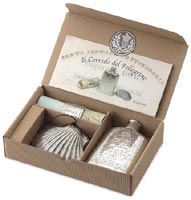Obiecte cu caracter religios
»
Pilgrim equipment
Pilgrim equipment - Cositor
The homo viator par excellence of the Middle Ages, the pilgrim, usually travelled on foot, especially as religious tradition saw walking as the most virtuous way of travelling. During that period (but the custom had been popular ever since the fall of the Roman Empire), all good Christians were expected to make a journey to an important holy place at least once in their lifetimes. This could be Rome, Santiago de Compostela and, especially, the sepulchre of Christ in the Holy Land. Ever since early medieval times, the protector of pilgrims has been St James the Apostle who is said to be buried at Santiago de Compostela. Symbols often found in portraits of St James, apart from the pilgrim's staff, are the Flask, the Scallop Shell (Coquille St Jacques for the French) and the Itinerant Map which at that time was a long rolled-up parchment, similar to the "Tabula Peutingeriana".
St James' Shell
Pilgrims walking to Santiago de Compostela in Galicia used a shell as their symbol. It could be found on the beaches of the nearby ocean and was used, both symbolically and practically, to collect water from brooks or springs during the long and often wearisome journey. Over time, the shell became the general emblem of pilgrims. It is a universally sacred symbol, both as an instrument of ritual and as an ornamental pattern. The shell symbolises the uterus, expecially the universal uterus, which contains the original Waters and the seeds of all living things. It evokes this obscure abyss of creative energy in a surprising way. The shell is still used as a living baptismal symbol: the object used to collect the holy water and pour it on the forehead of a new follower of Christ is often a metal shell.
"Tabula Peutingeriana"
We have reproduced part of an itinerant map from an engraving dated 1838 showing the route from Bavaria to Rome. This map is one of the oldest existing itinerant maps and contains instructions for pilgrims, tourists and travellers who wished to use the "carriage roads" built in Europe at that period. At that time, railways were still primitive and steam sailing boats still plied the seas. The instructions in three languages are particularly interesting. Customs posts and tollgates (D), ferries and toll bridges ("the so-called Pontatico toll"), stabling facilities and additional horses for crossing Alpine or Apennine passes were all indicated. The various states that existed in Italy prior to unification are clearly marked on the map.
The pilgrim's water flask
The flask depicts a pilgrim wearing traditional clothing: a cloak, shoes, a large woollen tunic, a broad-brimmed hat, a haversack and, above, all a "staff", a sturdy iron-tipped stick which has almost become the symbol of travelling on foot. The date A.D.MM commemorates the 2000 Millennium Jubilee.
St James' Shell
Pilgrims walking to Santiago de Compostela in Galicia used a shell as their symbol. It could be found on the beaches of the nearby ocean and was used, both symbolically and practically, to collect water from brooks or springs during the long and often wearisome journey. Over time, the shell became the general emblem of pilgrims. It is a universally sacred symbol, both as an instrument of ritual and as an ornamental pattern. The shell symbolises the uterus, expecially the universal uterus, which contains the original Waters and the seeds of all living things. It evokes this obscure abyss of creative energy in a surprising way. The shell is still used as a living baptismal symbol: the object used to collect the holy water and pour it on the forehead of a new follower of Christ is often a metal shell.
"Tabula Peutingeriana"
We have reproduced part of an itinerant map from an engraving dated 1838 showing the route from Bavaria to Rome. This map is one of the oldest existing itinerant maps and contains instructions for pilgrims, tourists and travellers who wished to use the "carriage roads" built in Europe at that period. At that time, railways were still primitive and steam sailing boats still plied the seas. The instructions in three languages are particularly interesting. Customs posts and tollgates (D), ferries and toll bridges ("the so-called Pontatico toll"), stabling facilities and additional horses for crossing Alpine or Apennine passes were all indicated. The various states that existed in Italy prior to unification are clearly marked on the map.
The pilgrim's water flask
The flask depicts a pilgrim wearing traditional clothing: a cloak, shoes, a large woollen tunic, a broad-brimmed hat, a haversack and, above, all a "staff", a sturdy iron-tipped stick which has almost become the symbol of travelling on foot. The date A.D.MM commemorates the 2000 Millennium Jubilee.

|
|
Sticluta
cm 9x h 14 11580 - IN STOCK |

|
|
Parchment set
cm Ø4x13 11584 - IN STOCK |

|
|
Pilgrim set
cm 24x15 11585 - IN STOCK |

|
|
Scoica din metal
cm 10x11 11590 - IN STOCK |
